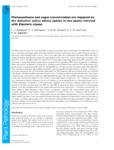Please use this identifier to cite or link to this item:
http://www.alice.cnptia.embrapa.br/alice/handle/doc/936993| Title: | Photosynthesis and sugar concentration are impaired by the defective active silicon uptake in rice plants infected with Bipolaris oryzae. |
| Authors: | DALLAGNOLA, L. J.  RODRIGUES, F. A.   CHAVES, A. R. de M.   VALE, F. X. R.   MATTA, F. M. da   |
| Affiliation: | AGNALDO RODRIGUES DE MELO CHAVES, CPATSA. |
| Date Issued: | 2012 |
| Citation: | Plant Pathology, v. 61, p. 1-10, 2012. |
| Description: | The effect of soluble silicon (Si) on photosynthetic parameters and soluble sugar concentrations was determined in leaves of rice cv. Oochikara and mutant plants of Oochikara defective in active Si uptake [low silicon 1 (lsi1)]. Plants were grown in hydroponic culture amended with 0 ()Si) or 2 mM Si (+Si), under either low or high photon flux density (PFD) and with or without inoculation with Bipolaris oryzae, the causal agent of brown spot of rice. Leaf Si concentration increased by 141 and 435% in +Si cv. Oochikara and by 119 and 251% in +Si lsi1 mutant plants under high and low PFD, respectively, com- pared with )Si plants. Plant biomass accumulation was improved by Si regardless of PFD, especially plants for cv. Oochikara. Brown spot severity was highest in )Si plants for cv. Oochikara and lsi1 mutant plants under low PFD. In the presence of Si, disease severity in plants grown under both low and high PFD was reduced, except for lsi1 mutant plants under high PFD. Plant inoculation reduced the photosynthetic parameters measured regardless of plant material or Si supply. A decrease of net carbon assimilation rate (A) of inoculated plants under low PFD compared with non-inoculated plants was associated with damage in the photosynthetic apparatus, except for +Si cv. Oochikara in which stomatal restriction [low water vapour conductance (gs)] contributed to A reduction. Under high PFD, damage to the photosynthetic apparatus of inoculated plants was the main reason for the reduction in A for +Si and )Si lsi1 mutant plants. In addition, for )Si cv. Oochikara, a reduction in gs contributed to reduced A. However, for +Si cv. Oochikara, gs was the limiting factor for A. Inoculated plants of +Si cv. Oochikara had higher A values than +Si lsi1 mutant plants, regardless of environmental conditions. Soluble sugars were not detected in leaf tissues of plants under low PFD. For high PFD, Si improved the hexose concentration in non-inoculated plants at 144 h after inoculation (hai) for lsi1 mutant plants and from 96 hai onwards for cv. Oochikara compared with Si plants. However, plant inoculation reduced hexose concentration compared with non-inoculated plants, mainly in +Si plants, regardless of plant material. Sucrose concentration increased in leaves of cv. Oochikara in the presence of Si whether inoculated or not. For +Si lsi1 mutant plants, sucrose concentration increased only at 48 hai compared with )Si plants, whether inoculated or not. The results of this study show that a minimum Si concentration is needed in leaf tissues of rice plants to avoid the negative impact of B. oryzae infection on photosynthesis and sugar concentration. High leaf Si con- centration resulted in an increased soluble sugar concentration and together, but in independent ways, soluble sugar and Si reduced brown spot severity of rice. |
| Thesagro: | Arroz Cereal Doença Mancha Marrom Oryza Sativa |
| NAL Thesaurus: | Rice Bipolaris oryzae Fungal brown spot Foliar diseases Gas exchange |
| Keywords: | Doença foliar Trocas gasosas Densidade de fluxo de fótons Açúcares solúveis Silício solúvel |
| Type of Material: | Artigo de periódico |
| Access: | openAccess |
| Appears in Collections: | Artigo em periódico indexado (CPATSA)  |
Files in This Item:
| File | Description | Size | Format | |
|---|---|---|---|---|
| Agnaldo12012.pdf | 282.53 kB | Adobe PDF |  View/Open |









